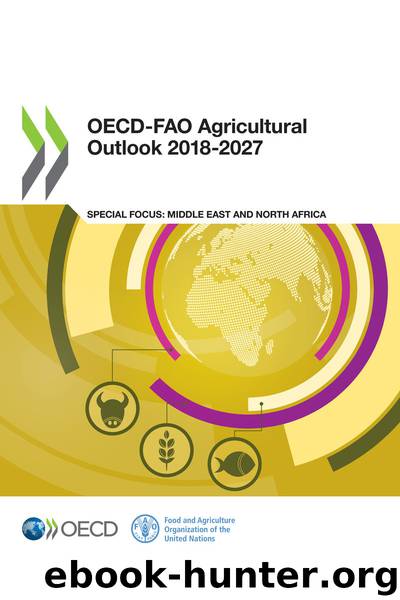OECD-FAO Agricultural Outlook 2018-2027 by OECD & FAO

Author:OECD & FAO
Language: eng
Format: epub
Tags: Trade/Agriculture and Food
Publisher: OECD Publishing and FAO
Published: 2018-07-02T16:00:00+00:00
Figure 3.8. Exports and stocks for Asian rice exporters
Source: OECD/FAO (2018), “OECD-FAO Agricultural Outlook”, OECD Agriculture statistics (database), http://dx.doi.org/10.1787/agr-outl-data-en.
StatLink http://dx.doi.org/10.1787/888933742967
China will remain the largest importer of rice throughout the next ten years despite imports declining by 16% (-1 Mt) from the base period. The largest import growth will be in African countries where demand is expected to outpace production. While production is expanding in African countries, it is restrained by climate conditions, limited use of inputs and infrastructure development. Nigeria, in particular, is projected to maintain its position as the second largest importer after China, increasing imports by 2 Mt, such that imports account for 55% of domestic consumption by 2027. Overall, imports in Africa are expected to increase from 15 Mt in the base period to 25 Mt in 2027, lifting Africa’s share of world imports from 34% to 44%. In addition to China and Nigeria, the group of the five major importers includes the Islamic Republic of Iran, Saudi Arabia and the Philippines. Altogether, these five countries are expected to account for about a third of global rice imports by 2027, compared to 28% in the base period. By region, LDC Sub Saharan Africa represents about 28% of the total imports by 2027.
Download
This site does not store any files on its server. We only index and link to content provided by other sites. Please contact the content providers to delete copyright contents if any and email us, we'll remove relevant links or contents immediately.
International Integration of the Brazilian Economy by Elias C. Grivoyannis(74633)
The Radium Girls by Kate Moore(11619)
Turbulence by E. J. Noyes(7700)
Nudge - Improving Decisions about Health, Wealth, and Happiness by Thaler Sunstein(7240)
The Black Swan by Nassim Nicholas Taleb(6762)
Rich Dad Poor Dad by Robert T. Kiyosaki(6174)
Pioneering Portfolio Management by David F. Swensen(6078)
Man-made Catastrophes and Risk Information Concealment by Dmitry Chernov & Didier Sornette(5645)
Zero to One by Peter Thiel(5488)
Secrecy World by Jake Bernstein(4388)
Millionaire: The Philanderer, Gambler, and Duelist Who Invented Modern Finance by Janet Gleeson(4092)
The Age of Surveillance Capitalism by Shoshana Zuboff(3983)
Skin in the Game by Nassim Nicholas Taleb(3965)
The Money Culture by Michael Lewis(3846)
Bullshit Jobs by David Graeber(3826)
Skin in the Game: Hidden Asymmetries in Daily Life by Nassim Nicholas Taleb(3720)
The Dhandho Investor by Mohnish Pabrai(3560)
The Wisdom of Finance by Mihir Desai(3523)
Blockchain Basics by Daniel Drescher(3327)
